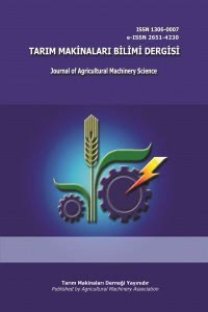A Review of Electrostatic Spraying for Agricultural Applications
Pesticides are toxic chemicals designed to control certain pests, diseases or weeds.They can easily contaminate the air, ground, water sources, wild animals, birds and aquatic lifewhen they run-off from fields. For these aspects the application of pesticide must be doneaccurately. One of the most important factors that affecting the success of application is choosingthe right equipment. New technologies on sensor and image analyzing process promoted thesuccess of application technique. Besides electrostatic spraying is a new trend to apply pesticideswith less drift potential. In recent years electrostatic spraying has been used in many otherapplications such as painting, ink printing etc. Researches have indicated electrostatic sprayingachieves better coverage of difficult targets than conventional spraying. Water consumption of thatkind of sprayers is up to 10 times less than conventional spraying. On the other hand this methodhas some difficulties and disadvantages. In this study, electrostatic spraying in agriculturalapplication was evaluated. Tractor mounted and mobile knapsack electrostatic sprayers wereexplained and some experimental results of them were discussed.
Anahtar Kelimeler:
Electrostatic fields, ULV, plant-protection treatments, coverage
A Review of Electrostatic Spraying for Agricultural Applications
Pesticides are toxic chemicals designed to control certain pests, diseases or weeds.They can easily contaminate the air, ground, water sources, wild animals, birds and aquatic lifewhen they run-off from fields. For these aspects the application of pesticide must be doneaccurately. One of the most important factors that affecting the success of application is choosingthe right equipment. New technologies on sensor and image analyzing process promoted thesuccess of application technique. Besides electrostatic spraying is a new trend to apply pesticideswith less drift potential. In recent years electrostatic spraying has been used in many otherapplications such as painting, ink printing etc. Researches have indicated electrostatic sprayingachieves better coverage of difficult targets than conventional spraying. Water consumption of thatkind of sprayers is up to 10 times less than conventional spraying. On the other hand this methodhas some difficulties and disadvantages. In this study, electrostatic spraying in agriculturalapplication was evaluated. Tractor mounted and mobile knapsack electrostatic sprayers wereexplained and some experimental results of them were discussed.
Keywords:
Electrostatic fields, ULV, plant-protection treatments, coverage,
___
- ANSI/ASAE S572.1, 2013. Spray Nozzle Classification by Droplet Spectra, W/Corr. 1 MAR2009 (R2013), pp.5 Anonymous, 2016a, March 2016.
- http://agriculture.vic.gov.au/agriculture/farmmanagement/ chemical-use/agricultural-chemicaluse/ spraying-spray-drift-and-off-target-damage, April 2016.
- Anonymous, 2016b. http://www.scientificamerican.com/article/pesticidedrift/, March 2016.
- Anonymous, 2016c. http://psep.cce.cornell.edu/facts-slidesself/ facts/gen-peapp-drop-app.aspx, February 2016.
- Anonymous, 2016d. http://psep.cce.cornell.edu/facts-slidesself/ facts/gen-peapp-drop-app.aspx, April 2016.
- Anonymous, 2016e. http://vtpp.ext.vt.edu/pesticide-safetyeducation- program/pesticide-applicationequipment/ controlled-droplet-applicators-cda, April 2016.
- Anonymous, 2016f. http://english.finishingbrands.eu/about_us/ransburg.asp, April 2016.
- Anonymous, 2016g. http://bowleselectrostaticpainting.com/history-andexplanation- of-the-electrostatic-painting-process, April 2016.
- Anonymous, 2016h. http://www.ransburgcollection.com/Default.aspx?tabid= 66, March 2016.
- Anonymous, 2016i. http://www.virginiafruit.ento.vt.edu/Electrostatic/electros tatic, January 2016.
- Anonymous, 2016j. http://www.protecsolutions.com.tr/en/fields-ofusage. php?id=100114), March 2016.
- Arnold A.J. & B.J. Pye, 1980. Spray Application with Charged Rotary Atomizers. British Crop Protection Council Monograph 24, 109-125.
- Deveau J., 2009. Subject: Six Elements of Effective Spraying in Orchards and Vineyards.
- http://www.omafra.gov.on.ca/english/crops/facts/09- 039.htm, March 2016
- Giles D. K., T. C. Blewett, 1991. Effects of Conventional and Reduced-Volume, Charged-Spray Application Techniques on Dislodgeable Foliar Residue of Captan on Strawberries. J. Agric. Food Chem. 1991, 39, 1646-1651.
- Law, S. E, 1978. Embedded-Electrode Electrostatic-Induction Spray Charging Nozzle: Theoretical and Engineering Design. Transactions of the ASAE 21, 1096-1104
- Meijden, G., 1998. Pesticide Application Techniques In West- Africa. Food and Agriculture Organization of the United Nations FAO Regional Office for Africa Accra, Ghana.
- Ozkan H. E., 2016. Subject: Best Management Practices for Boom Spraying. http://ohioline.osu.edu/factsheet/fabe- 527, Agriculture and Natural Resources, FABE-527. April 2016
- Patel, M. K., H. K. Sahoo, M. K. Nayak, A. Kumar, C. Ghanshyam, A. Kumar, 2015. Electrostatic Nozzle: New Trends in Agricultural Pesticides Spraying. SSRG International Journal of Electrical and Electronics Engineering (SSRG-IJEEE) – EFES April2015, ISSN:2348 – 8379, pp 6-11.
- Rayleigh, L., 1882. On the Equilibrium of Liquid Conducting Masses Charged with Electricity. Philosophical Magazine 14: 184–186. doi:10.1080/14786448208628425
- Wolf T., 2009. Best Management Practices for Herbicide Application Technology. Weeds, Herbicides and Management Volume 2. pp 24-30.
- ISSN: 1306-0007
- Başlangıç: 2005
- Yayıncı: Tarım Makinaları Derneği
Sayıdaki Diğer Makaleler
Tuncay GÜNHAN, Abdülkadir YAĞCIOĞLU
Traktör ve Makina Üç-Nokta Askı Düzeni Boyutlarının Yük Kaldırma Kapasitesine Etkisi*
Possibilities of Killing Weeds by Microwave Power
Ikbal AYGUN, Engin CAKIR, Koray KACAN
A Review of Electrostatic Spraying for Agricultural Applications
Erkan URKAN, Huseyin GULER, Firat KOMEKCI
Tarımda Dijital Dönüşüm; İnsansız Hava Araçları Kullanımı
Süleyman TÜRKSEVEN, Mehmet Zeki KIZMAZ, Arif Behiç TEKİN, Erkan URKAN, Ahmet Tansel SERİM
Tek Dane Ekici Düzen Performansının Optimizasyonuna Yeni Bir Yaklaşım: Akıllı Vakum Diski*
Şahin DOĞAN, Adnan DEĞİRMENCİOĞLU, Cengiz ÖZARSLAN, Fazilet N. ALAYUNT
